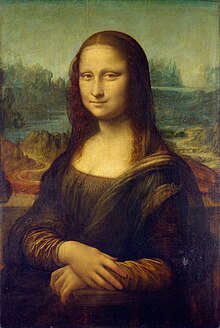Mona Lisa replicas and reinterpretations
Prominent 20th-century artists such as Marcel Duchamp and Salvador Dalí have also produced derivative works, manipulating Mona Lisa's image to suit their own aesthetic.
[2] At the beginning of the 16th century, Leonardo da Vinci was commissioned by Florentine nobleman Francesco del Giocondo to paint a portrait of his wife, Lisa.
"[2] The painting's theft on August 11, 1911, and the subsequent media frenzy surrounding the investigation and its recovery ignited public interest and led to the Mona Lisa gaining its current standing.
[14] Some experts, including Frank Zöllner, Martin Kemp and Luke Syson denied the attribution;[15][16] professors such as Salvatore Lorusso, Andrea Natali,[17] and John F Asmus supported it;[18] others like Alessandro Vezzosi and Carlo Pedretti were uncertain.
[22] Two nude paintings bearing similarities to Leonardo da Vinci's original were part of a 2009 exhibition of artwork inspired by Mona Lisa.
[24] The nude in question, discovered behind a wall in a private library, reportedly belonged to an uncle of Napoleon Bonaparte, who owned another of Leonardo's paintings.
[6] Facial features bear only vague resemblance, but landscape, compositional and technical details correspond to those of the Mona Lisa known worldwide today.
Titled Le Rire (The Laugh), the artwork was displayed at the "Incoherents" exhibition in Paris at the time of its creation, making it among the earliest known instances of Mona Lisa's image being re-interpreted using contemporary irony.
Further interpretations by avant-garde artists beginning in the early 20th century, coinciding with the artwork's theft, attest to Mona Lisa's popularity as an irresistible target.
Marcel Duchamp, among the most influential artists of his generation, in 1919 may have inadvertently set the standard for modern manifestations of Mona Lisa simply by adding a goatee to an existing postcard print of Leonardo's original.
Duchamp pioneered the concept of readymades, which involves taking mundane objects not generally considered to be art and transforming them artistically, sometimes by simply renaming them and placing them in a gallery setting.
The letters L-H-O-O-Q pronounced in French form the sentence Elle a chaud au cul, colloquially translating into English as "She has a hot ass.
[32] In December 1962, André Malraux, the first French minister of cultural affairs, lent the Mona Lisa to the United States at the request of First Lady Jacqueline Kennedy.
[44] British street artist Banksy in the first decade of the 21st century stenciled a "Mona Lisa Mujaheddin" holding a rocket launcher, and another mooning the viewer.
[45][clarification needed] Mona Lisa's iconic face has been available for years in all forms, appearing in advertisements for fashion and travel industries, and on the cover of magazines.
The sheer number and variety of replicas and reproductions since its creation in the early 16th century illustrates a so-called self-reinforcing dynamic; utilized in advertising because of its familiarity, its fame is reinforced thereby.
Struggling artists in China paint them by the hundreds to supply the demand of American and European markets, and Mona Lisa is among the most popular requests.
[47] In the 2003 film Elf, Buddy uses an Etch-a-Sketch to draw the Mona Lisa in the process of building Santa Land by the North Pole in Gimbels.
In Horton Hears A Who, the Mayor Ned McDodd shows his only son Jojo a family gallery where in one part his great grandmother is parodied as the Mona Lisa.
And in My Little Pony: Equestria Girls – Friendship Games, there is a cake that Pinkie Pie and Fluttershy have baked with a picture of the Mona Lisa inside.
[49] A replica of Mona Lisa publicized as the "world's smallest" was painted by Andrew Nichols of New Hampshire (USA) in 2011, intending "to break the record."
[citation needed] In 2013, a far smaller version of the painting, entitled the Mini Lisa, was created by a Georgia Institute of Technology student named Keith Carroll.
[50] High school students attracted media attention in 2011 by recreating Mona Lisa on Daytona Beach, Florida (USA), using seaweed which had accumulated on shore.
[51] In 2012 the Portuguese designer Luís Silva created a poster for a campaign against violence on women representing Mona Lisa with a sore eye and a sombre expression, with the slogan "Could you live without her smile?
A 2011 exhibition titled Da Vinci, The Genius at the Frazier Museum in Louisville, Kentucky attracted attention by having a Mona Lisa constructed by Lego artist Brian Korte.
[55][56][57] Media coverage of the many incarnations of Mona Lisa often allude to the likely disbelief of Leonardo himself; of the intrigue she would come to inspire, and the unimaginable extremes of her re-portrayal.




